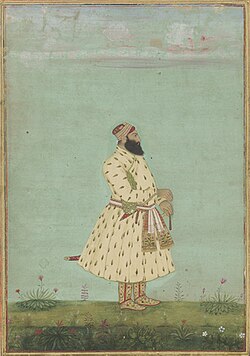Safdarjung's rebellion
The Safdarjung's rebellion occurred on 10 March 1753 during the waning years of the Mughal Empire. It was characterized by a conflict between Safdarjung, the Nawab of Oudh, and the Mughal emperor Ahmad Shah Bahadur, alongside his court factions.
| Safdarjung's rebellion | |||||||
|---|---|---|---|---|---|---|---|
 | |||||||
| |||||||
| Belligerents | |||||||
|
|
| ||||||
| Commanders and leaders | |||||||
|
Sayyid Salabat Khan Zulfiqar Jang |
| ||||||
Background
Tensions between Safdarjung and Intizam-ud-Daulah, another prominent noble, had been escalating since March 1753. Emperor Ahmad Shah Bahadur lacked the authority to control these powerful nobles. Although the emperor and his mother initially ordered Safdarjung to return to his governorship in Oudh, Safdarjung delayed his departure. Eventually, on 26 March 1753, he left Delhi but, instead of returning to Oudh, set up camp just outside the city with his army. Safdarjung wavered between allying with the emperor or taking action against him.
For a time, both sides hesitated to act, but Safdarjung's position shifted after receiving reinforcements from Suraj Mal, the Jat ruler, and Salabat Khan. Gaining confidence, Safdarjung encouraged the Jats to loot Old Delhi.[4] On 9 May 1753, the Jats plundered the city, burning several areas. Many civilians fled to the fortified New Delhi, while the Jats extracted lakhs of rupees from the city's outskirts.[1]
In response, on 13 May 1753, Ahmad Shah Bahadur dismissed Safdarjung as Wazir (prime minister) and appointed Intizam-ud-Daulah in his place, with Imad-ul-Mulk as Mir Bakshi (chief military officer). Safdarjung retaliated by declaring a eunuch as a rival emperor under the name Akbar Ādilshāh and appointing himself as Wazir and Sarbuland Khan as Mir Bakshi.[1]
Reference
- ↑ 1.0 1.1 1.2 Sarkar, Jadunath (2007). Fall of the Mughal Empire:vol one. Orient Black Swan. pp. 236–249.
22 miles south of Delhi, as far as Ballabgarh, was wrested by the emperor's men, and finally on 7th November Safdar Jang accepted defeat.
- ↑ The Army Quarterly and Defence Journal, Volume 114. West of England Press. 1984.
- ↑ Chopra, Prabha (1976). Delhi Gazetteer. The Unit. p. 1165.
- ↑ Hasan, M. (2002). HISTORY OF ISLAM (2 Vol. Set). Adam Publishers. ISBN 978-8-174-3-50190.